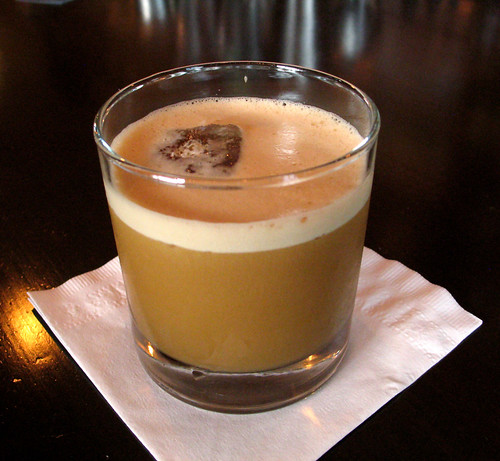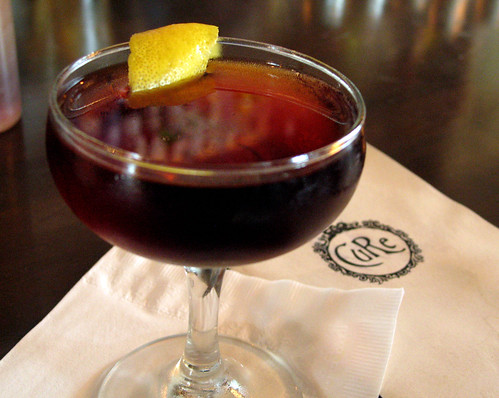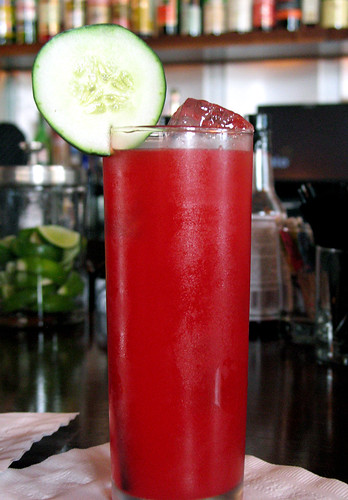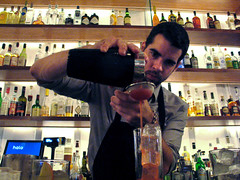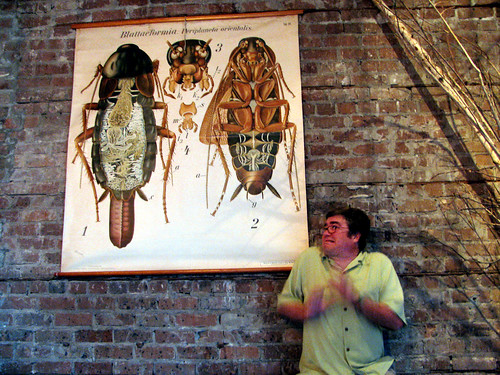It was a tough decision which Spirited Dinner to go to this year — so many menus looked great, we were teetering between Wolfe’s in the Warehouse and Iris and we thought long and hard about trying someplace new to us — but in the end it was kind of a shoo-in. Jeff “Beachbum” Berry was mixing for another dinner this year, and last year he and Wayne Curtis made fantastic drinks to accompany Chef Chris DeBarr’s “Modern Tiki Cuisine” for one of the best meals I’d ever had … well, as much of it as I remember.
Bum and Wayne’s drinks contained a total of 7-1/2 ounces of rum during that three-hour meal, and it didn’t help that earlier in the day I’d had tastes of six Scotches, ten gins, eight brandies plus the Cocktail Hour event (inexplicably and invariably scheduled right before the Spirited Dinners). Once I finally decided that I wanted the Bum’s drink pairings again, especially since this year he teamed up with Martin Cate, formerly of Forbidden Island and soon to be proprietor of Smuggler’s Cove in San Francisco, I knew some preparation was in order. I decided I’d better take it easy during this year’s Tales Thursday so that this meal wouldn’t completely liquefy me — no taking three seminars in a row that involve copious amounts of spirits tasting in which Chuck fails to make use of the spit buckets.
Rick, giving friend that he is, helped out by adding an additional rule to his previous list of ten: “Chuck is not allowed to drink before the Spirited Dinner.” Despite that, I did manage to make it to the Cocktail Hour event, which 1) should be in the Presbytere every year, as it was a beautiful location for the event, and 2) should never again be scheduled before the Spirited Dinners unless they’re willing to provide buckets for us to be poured into. Fortunately the gods were looking out for me at Cocktail Hour by causing my favorite bartenders to all run out of cups by the time I got to them.
A short walk from the Presbytere took us to GW Fins, one of the city’s newer restaurants (i.e., opened during the 21st Century rather than the 19th or early 20th) and a renowned destination for seafood. Theirs was one of the two or three most exciting looking menus on the Tales site, plus we knew a ton of people who were going to this one too, all elements for a great evening. Wes and I sat with several of our friends from Seattle and Portland, and we toasted each other with the welcoming cocktail, first of six for the evening.
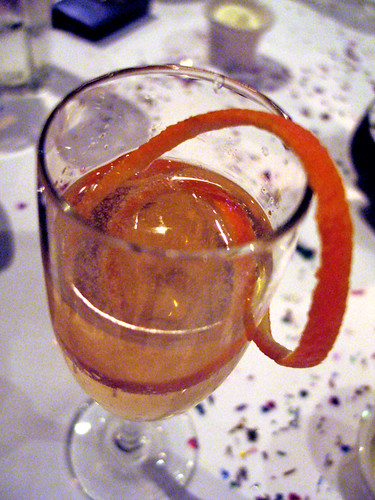
THE CRESCENT CITY BLOSSOM
(by Martin Cate)
2-1/2 ounces Moët & Chandon White Star Champagne
1 ounce Plymouth Gin
1 ounce St. Germain Elderflower Liqueur
1/4 ounce Stirrings Blood Orange Bitters
Combine gin, St. Germain, and bitters in an ice-filled mixing glass. Stir until well chilled and strain into a Champagne glass. Top with Moët & Chandon. Garnish with a thin, 8-inch orange peel spiral.
Finally, after we had settled in and begun enjoying our aperitivo, our intrepid mixologists, Beachbum Berry and Martin Cate, arrived (along with GW Fins’ chef de cuisine) to welcome us and talk a little bit about what was to come, and how quickly their ideas for perfect cocktail pairings came to them as soon as they saw the proposed menu.
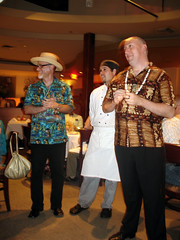
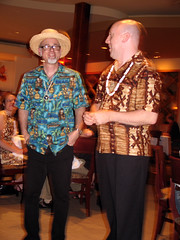
Some will argue that cocktail pairings are even better than wine pairings, as you can tailor the drink to the food very precisely. Whether you believe that or not, I’ll say that this particular meal featured some of the best food-beverage pairings I’ve ever had.
And now … dinner is served!
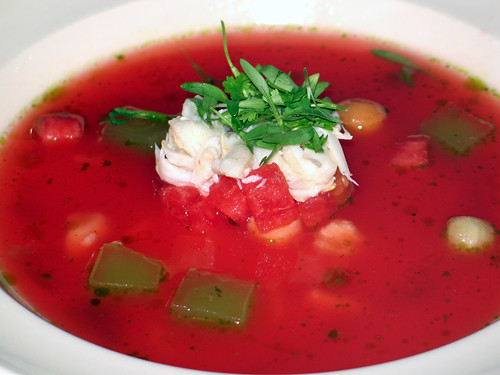
We started with a Chilled Melon Soup, in the center of which was a huge scoop of jumbo lump crabmeat topped with cilantro sprouts. Mixed into the soup were little balls of watermelon plus cantaloupe and honeydew melons, plus cubes of lime gelée, which provided a delightful little burst of tartness and change of texture every few bites or so. The soup was bright, cool, refreshing and delicious — the lightness of the dish was welcome to those of us who’d been having hollandaise-napped egg dishes for breakfast or huge piles of fried seafood for lunch. And, oh my Gawd, that crabmeat … I’ll eat pretty much anything that has a scoop of jumbo lump crabmeat in the middle.
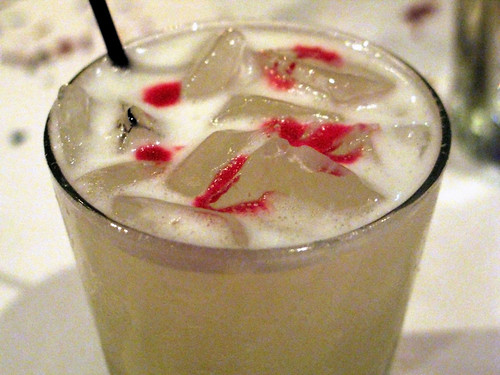
Accompanying the watermelon soup was our first cocktail, the Menehune Gonzalez, made with blanco tequila, a great white agricole rum from Martinique, green Chartreuse and a housemade hibiscus tincture, a bottle of which being provided to each table so that each guest could add some to his or her individual serving as they pleased. Lovely drink, and the flavors of both the base spirits and the Chartreuse played off one another quite nicely. The hibiscus gave it some color affinity as well as a bit of extra tartness, along the lines of the lime gele in the soup. We were off to a grand start.
MENEHUNE GONZALEZ
(by Martin Cate)
1 ounce El Tesoro Blanco tequila
1 ounce Rhum Clément Première Canne rum
3/4 ounce fresh lime juice
1/2 ounce orgeat
1/4 ounce green Chartreuse
Half an egg white
Shake vigorously and strain into a small ice-filled old fashioned glass.
Top with 3 to 4 drops hibiscus tincture.
To make a hibiscus tincture, take an ounce of dried hibiscus flowers (jamaica) and steep in about 5 ounces of alcohol (vodka or overproof white rum) for a couple of days, then strain and bottle.
Quick on the heels of this great opening to the meal was our second (well, technically our third, but second course) cocktail, Captain Vadrna’s Grog — Old New Orleans Cajun Spiced Rum, lime and grapefruit juices and demerara syrup. Nice big aromatic cinnamon stick as garnish, and … a pirate flag! Almost immediately, my friend Rocky and I broke into a chorus of “Yo Ho, Yo Ho, A Pirate’s Life For Me” (assisted by some quick Googling on Rocky’s phone, as we both ran out of lyrics after the first verse). Pretty quickly a fair swath of the restaruant was singing along, undoubtedly to the bewilderment of the guests who were there for the restaurant’s regular menu and not for the Spirited Dinner.
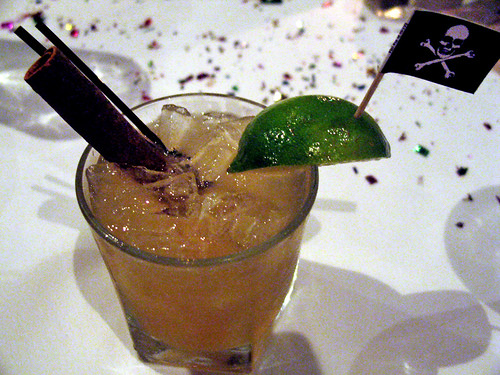
CAPTAIN VADRNA’S GROG
(by Jeff Berry)
2-1/2 ounces Old New Orleans Cajun Spiced rum
1/2 ounce white grapefruit juice
3/4 ounce fresh lime juice
3/4 ounce Demerara sugar syrup (1:1)
Dash Angostura bitters
Shake well with plenty of ice, then pour unstrained into a double old-fashioned glass. Garnish with a cinnamon stick and vanilla bean both speared to a lime wedge, floated in drink.
Word trickled back from the bar that once Bum and Martin heard that they said they knew the party had finally started … either that or had already gotten out of hand, I forget which.
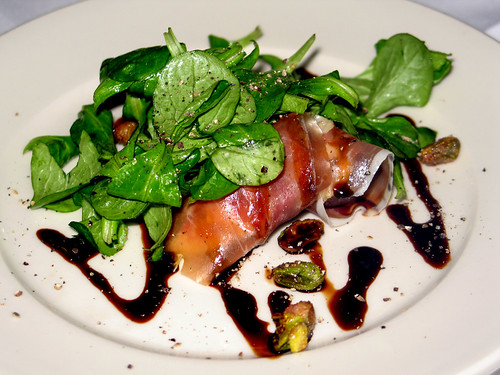
Before we got too far ahead of ourselves, the 2nd course arrived: Prosciutto-Wrapped Figs with mâche, cinnamon mascarpone and candied pistachios. I’d almost eat this as a dessert — fruit stuffed with spiced cheese and wrapped in pig. It’s many of my favorite things, on a plate! Oh, and greens to make it officially salady, but … the sweetness and nuttiness of the mche went beautifully with the spiced rum in that cocktail. So did the cinnamon-spiced mascarpone, which caught the cinnamon and nutmeg notes of the rum. The lettuce was gorgeous with the pistachios too, and the candied crunch of the nuts was balanced by the tart citrus juices. Salads are notoriously difficult to pair with wines, but this one, even with its balsamic drizzle, was superb with this drink, and the drink was superb with the dish.
Third cocktail! Oh my, this is a big one. Served in a pilsner glass — we’re not messing around. This was the Hedgehog’s Dilemma — caramelized mango, lemon juice, Noilly Prat dry vermouth, passion fruit syrup, Myers’s Platinum rum and Angostura bitters. A fantastic drink, and on its own I’d be more than happy to order it again from any tiki bar’s menu.
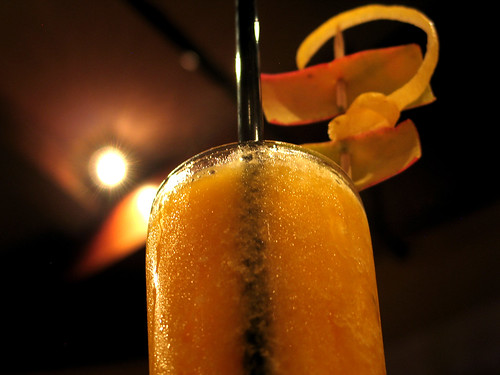
HEDGEHOG’S DILEMMA
(by Martin Cate)
Half of a fresh mango
Teaspoon of raw sugar
1 ounce Noilly Prat dry vermouth
1/2 ounce passion fruit syrup (equal parts 2:1 simple syrup and Funkin Passion Fruit Purée)
1/2 ounce fresh lemon juice
1/4 ounce simple syrup (optional – to taste)
1-1/2 ounces Myers’s Platinum Rum
Dash Angostura bitters
Dice half of a mango into 3/4. cubes. Toss with 1 teaspoon of raw sugar. Saut in a non-stick skillet over medium heat until the mango chunks are browned on all sides. Remove from heat and let cool.
In a mixing glass, add the mango chunks and dry vermouth and muddle. Add the remaining ingredients and shake with cracked ice. Double strain into a cocktail glass and garnish with mango chunks and a lemon twist on a skewer.
It’s so rare to get mango in a really good cocktail (those nasty mango-flavored rums and vodkas just don’t cut it) and this one, with tart passion fruit and tempered a bit by the vermouth, was probably the best mango-based cocktail I’d ever had (at least that I can remember). But when paired with this …
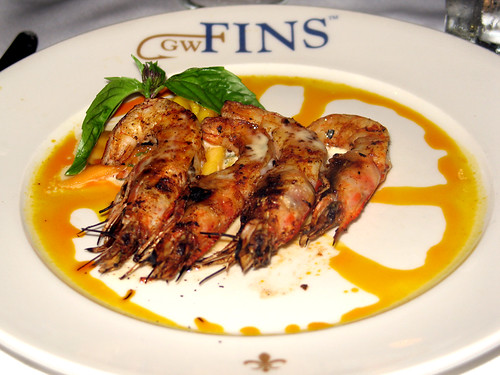
Wood-Grilled Louisiana Shrimp, with lemon and papaya relish. This is classic New Orleans cuisine, adding the consideration that New Orleans is the northernmost port in the Caribbean. Heads-on shrimp (which you can almost never get in a restaurant in places like California, lest wimpy, timid patrons run screaming from the dining room at the sight of the monster on their plate, still wearing its head . where so much of the flavor is!), perfectly seasoned, nice and peppery but not too much so, with the tropical flavor of the papaya in the glaze and the sauce that married so beautifully with the drink that I practically wanted to buy them a wedding present. This dish was such a synthesis of classic Creole and Caribbean flavors and techniques, with that drink sailing up to meet it, that it made me very happy.
Four pretty huge shrimp were both quite enough, considering we’d be having five courses, yet left me wanting more. Then entire pineapples were brought to the table.
It was our next drink! Applause and giggles greeted this one, as the pineapples had straws sticking out of them … we lifted the lid to find the whole fruit filled with a beverage, man! This was the Miehana — pineapple, orange and lime juices, Cruzan Estate dark rum, Cruzan Coconut Rum and Grand Marnier. Also very refreshing, and not as sweet as you’d think it might be.

MIEHANA
(by Jeff Berry)
1 ounce fresh lime juice
1 ounce orange juice
1 ounce unsweetened pineapple juice
1 ounce Grand Marnier
1 ounce Cruzan Estate Dark rum
1 ounce Cruzan Coconut rum
Shake well with ice cubes. Pour unstrained into a cored pineapple. If necessary, add more ice to fill.
It was another drink I’d be happy to have in any tiki bar, but in a tiki bar you’re generally not going to get anything like this:
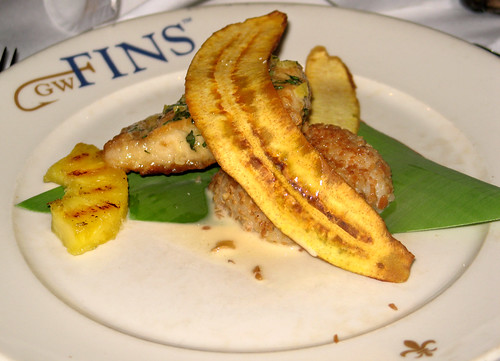
Our 4th course was Pineapple Basil Glazed Mahimahi, with coconut-cashew rice, crispy plantains and lemongrass butter. This is the kind of dish people wished they could have gotten in the “Polynesian” restaurants in the 1950s and ’60s, because it epitomizes what that cuisine aspired to but rarely attained. Gorgeous tropical flavors, a perfectly grilled piece of fish, and all of the flavors of the dish and the cocktail working in harmony with each other. This dish actually made us all laugh — that’s how delightful it was. And lest you think it was overly sweet, it wasn’t. The acids in the cocktail helped cut through the sugars, the richness of the lemongrass beurre blanc added richness to balance the acids and sugars, the plantains added texture and starch and were decidedly not sweet but the flavors complemented everything else. That drink with this course is one of the best food-drink pairings I’ve ever had. Fun fun fun.

PUPULE
(by Jeff Berry)
1 ounce unsweetened pineapple juice
1/2 ounce fresh lemon juice
1/4 ounce Bols white crème de cacao
1/4 ounce Chambord
1 ounce Angostura 1919 rum
Shake well with ice cubes. Strain into a chilled cocktail glass. Garnish with a small purple orchid.
Another cocktail arrived (good lord, was this really the sixth drink?), called the Pupule. Most certainly a dessert cocktail, but again, not overly sweet and well-balanced.
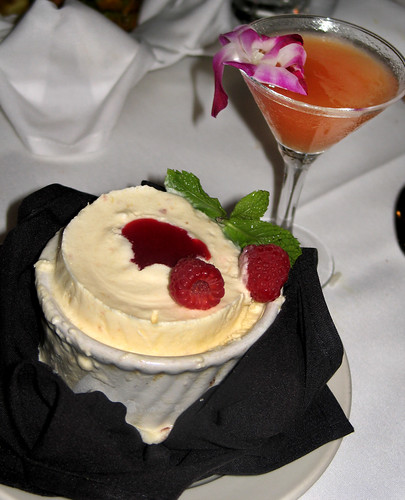
Our dessert was a Frozen Peach Soufflé, with a raspberry coulis and a few fresh raspberries. Simple, delicious and summery, and entirely appropriate given that it was roasting outside. The rum, with hints of chocolate plus more raspberry, were just the thing to have with this dessert. It’s such a pleasure to have a dessert cocktail that’s not filled with heavy cream or with enough liqueurs to make it as sweet as a candy bar.
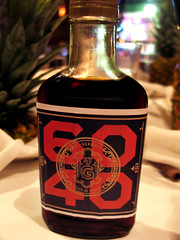
We had a fantastic time, fantastic food, fantastic drinks (and Rocky realized that the Miehana came in the ultimate go-cup), but it wasn’t quite over yet. There were lovely parting gifts!
We were each presented with a bottled cocktail called the 60/40, a combination of 60% Averna amaro and 40% St. Germain elderflower liqueur, which went right into the back pocket. It was the perfect amount of liquor to last us until we could walk all the way to Arnaud’s French 75 Bar for nightcaps . right across the street. (Okay, the 60/40 survived intact until after we went home.)
Thanks again to GW Fins for a memorable meal, Martin and Jeff for the drinks, and to Jeff for providing the recipes and coring all those pineapples!

